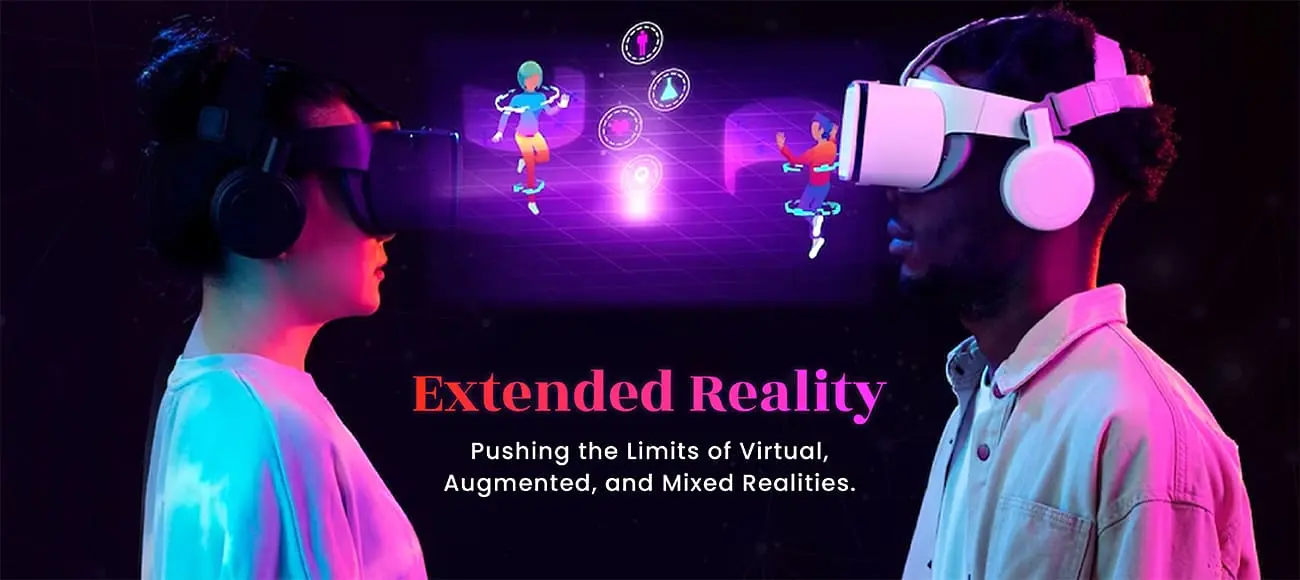
11 Oct Extended Reality: Blurring the Boundaries of Virtual, Augmented, and Mixed Realities.
In recent years, the realm of digital experiences has been revolutionized by a convergence of technologies known as Extended Reality (XR). XR serves as an all-encompassing term that includes Virtual Reality (VR), Augmented Reality (AR), and Mixed Reality (MR). These immersive technologies have the power to transport us to virtual worlds, enhance our real-world surroundings, and blend the physical and digital realms in unprecedented ways. In this blog, we will explore the fascinating world of Extended Reality, delving into its various forms, applications, and the transformative impact it has across industries.
Understanding the Spectrum of Extended Reality:
Extended Reality encompasses a spectrum of immersive technologies, each offering a unique blend of virtual and real-world experiences.
Virtual Reality (VR) creates a fully immersive digital environment, blocking out the physical world and replacing it with a simulated reality. Users don headsets and interact with a virtual world, often through handheld controllers or motion-tracking devices. VR has gained popularity in gaming, entertainment, and training applications, allowing users to explore new worlds, simulate real-life scenarios, and immerse themselves in captivating experiences.
Augmented Reality (AR) enriches our perception and interaction with the real world by superimposing digital information onto it. AR experiences are typically accessed through smartphones, tablets, or smart glasses, which use cameras to blend the virtual elements seamlessly with the physical surroundings. AR has found applications in fields such as education, healthcare, and retail, enabling users to access information, visualize objects, and interact with virtual content in real-time.
Mixed Reality (MR) combines the best of VR and AR, allowing users to interact with both virtual and real-world elements simultaneously. MR experiences often require specialized headsets with built-in cameras and sensors that can map and track the physical environment, enabling the digital content to anchor and interact with the real world. This technology is particularly valuable in industrial sectors, where workers can overlay virtual information on physical objects for training, design, or remote collaboration purposes.
Applications and Impact of Extended Reality:
Extended Reality has a profound impact across numerous industries, offering transformative applications and unlocking new possibilities.
In the field of healthcare, XR technologies are revolutionizing medical training, patient care, and therapy. Medical professionals can use VR simulations to practice complex surgeries in a risk-free environment, enhancing their skills and reducing the potential for errors. AR is utilized in surgical navigation, enabling surgeons to overlay vital patient information directly onto their field of view, improving precision and efficiency. Furthermore, XR is transforming patient experiences by providing distraction therapy, reducing pain perception, and assisting in physical and cognitive rehabilitation.
Education is another sector benefiting from Extended Reality. VR and AR technologies enable immersive and interactive learning experiences, making education more engaging and effective. Students can explore historical events, dive into virtual science experiments, or interact with three-dimensional models to deepen their understanding. AR allows for the augmentation of textbooks, providing additional context and information, while MR enables collaborative learning experiences, bringing together students from different locations in shared virtual spaces.
In architecture and design, XR has become an invaluable tool for visualization and collaboration. Architects and interior designers can create virtual walkthroughs of buildings, enabling clients to experience and provide feedback before construction begins. With AR, users can preview furniture or decor in their physical spaces, allowing them to make informed purchasing decisions. MR facilitates remote collaboration between teams, allowing designers and stakeholders to interact with virtual models, make changes in real-time, and discuss designs as if they were physically present.
XR also has a significant impact on the entertainment and gaming industries. VR immerses players in realistic and captivating virtual worlds, providing unparalleled gaming experiences. AR-based mobile games, such as Pokémon Go, have taken the world by storm, blurring the boundaries between the digital and physical realms. Additionally, MR offers innovative possibilities for interactive storytelling and live performances, where virtual characters or objects can seamlessly interact with real-world environments and audiences.
Ethical Considerations and Challenges:
While Extended Reality holds tremendous potential, it also raises ethical considerations and challenges. Privacy and data security become paramount, as XR technologies collect and process vast amounts of user data. Safeguarding personal information and ensuring responsible data practices are crucial to maintain user trust and protect individuals’ privacy. Another concern is the potential for addiction and psychological impact. Immersive experiences in VR, for example, can blur the line between the virtual and real world, leading to dissociation or neglect of real-life responsibilities. Responsible use of XR technologies and setting limits becomes essential to prevent negative consequences.
Furthermore, accessibility is a challenge that needs to be addressed. Ensuring that XR experiences are inclusive and accessible to individuals with disabilities is crucial for a truly equitable digital future. Efforts are being made to develop accessible hardware, software, and content, enabling everyone to benefit from Extended Reality.
Conclusion:
Extended Reality is reshaping our perception of the digital and physical worlds, offering immersive and transformative experiences across industries. From healthcare and education to entertainment and design, XR technologies like VR, AR, and MR are pushing boundaries and unlocking new possibilities. As the technology continues to evolve, it is crucial to address ethical considerations, ensure accessibility, and foster responsible use. By harnessing the power of Extended Reality responsibly, we can create a future where virtual and real worlds harmoniously coexist, enhancing our lives and driving innovation.

Sorry, the comment form is closed at this time.